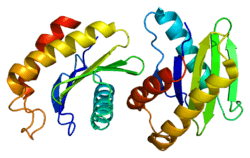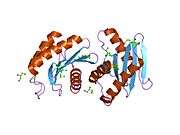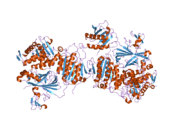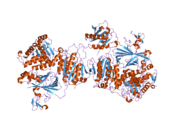SEC22B
| View/Edit Human | View/Edit Mouse |
Vesicle-trafficking protein SEC22b is a protein that in humans is encoded by the SEC22B gene.[3][4][5]
The protein encoded by this gene is a member of the SEC22 family of vesicle trafficking proteins. It seems to complex with SNARE and it is thought to play a role in the ER-Golgi protein trafficking. This protein has strong similarity to Mus musculus and Cricetulus griseus proteins. There is evidence for use of multiple polyadenylation sites for the transcript.[5] SEC22B has been shown to interact with syntaxin 18.
References
- ↑ "Human PubMed Reference:".
- ↑ "Mouse PubMed Reference:".
- ↑ Hay JC; Chao DS; Kuo CS; Scheller RH (Apr 1997). "Protein interactions regulating vesicle transport between the endoplasmic reticulum and Golgi apparatus in mammalian cells". Cell. 89 (1): 149–58. doi:10.1016/S0092-8674(00)80191-9. PMID 9094723.
- ↑ Okumura AJ; Hatsuzawa K; Tamura T; Nagaya H; Saeki K; Okumura F; Nagao K; Nishikawa M; Yoshimura A; Wada I (Feb 2006). "Involvement of a novel Q-SNARE, D12, in quality control of the endomembrane system". J Biol Chem. 281 (7): 4495–506. doi:10.1074/jbc.M509715200. PMID 16354670.
- 1 2 "Entrez Gene: SEC22B SEC22 vesicle trafficking protein homolog B (S. cerevisiae)".
Further reading
- Chi A, Valencia JC, Hu ZZ, et al. (2007). "Proteomic and bioinformatic characterization of the biogenesis and function of melanosomes". J. Proteome Res. 5 (11): 3135–44. doi:10.1021/pr060363j. PMID 17081065.
- Rual JF, Venkatesan K, Hao T, et al. (2005). "Towards a proteome-scale map of the human protein-protein interaction network". Nature. 437 (7062): 1173–8. doi:10.1038/nature04209. PMID 16189514.
- Gerhard DS, Wagner L, Feingold EA, et al. (2004). "The Status, Quality, and Expansion of the NIH Full-Length cDNA Project: The Mammalian Gene Collection (MGC)". Genome Res. 14 (10B): 2121–7. doi:10.1101/gr.2596504. PMC 528928
 . PMID 15489334.
. PMID 15489334. - Breuza L, Halbeisen R, Jenö P, et al. (2004). "Proteomics of endoplasmic reticulum-Golgi intermediate compartment (ERGIC) membranes from brefeldin A-treated HepG2 cells identifies ERGIC-32, a new cycling protein that interacts with human Erv46". J. Biol. Chem. 279 (45): 47242–53. doi:10.1074/jbc.M406644200. PMID 15308636.
- Nakajima K, Hirose H, Taniguchi M, et al. (2005). "Involvement of BNIP1 in apoptosis and endoplasmic reticulum membrane fusion". EMBO J. 23 (16): 3216–26. doi:10.1038/sj.emboj.7600333. PMC 514507
 . PMID 15272311.
. PMID 15272311. - Fu GK, Wang JT, Yang J, et al. (2005). "Circular rapid amplification of cDNA ends for high-throughput extension cloning of partial genes". Genomics. 84 (1): 205–10. doi:10.1016/j.ygeno.2004.01.011. PMID 15203218.
- Hirose H, Arasaki K, Dohmae N, et al. (2005). "Implication of ZW10 in membrane trafficking between the endoplasmic reticulum and Golgi". EMBO J. 23 (6): 1267–78. doi:10.1038/sj.emboj.7600135. PMC 381410
 . PMID 15029241.
. PMID 15029241. - Strausberg RL, Feingold EA, Grouse LH, et al. (2003). "Generation and initial analysis of more than 15,000 full-length human and mouse cDNA sequences". Proc. Natl. Acad. Sci. U.S.A. 99 (26): 16899–903. doi:10.1073/pnas.242603899. PMC 139241
 . PMID 12477932.
. PMID 12477932. - Zhang QH, Ye M, Wu XY, et al. (2001). "Cloning and Functional Analysis of cDNAs with Open Reading Frames for 300 Previously Undefined Genes Expressed in CD34+ Hematopoietic Stem/Progenitor Cells". Genome Res. 10 (10): 1546–60. doi:10.1101/gr.140200. PMC 310934
 . PMID 11042152.
. PMID 11042152. - Xu D; Joglekar AP; Williams AL; Hay JC (2001). "Subunit structure of a mammalian ER/Golgi SNARE complex". J. Biol. Chem. 275 (50): 39631–9. doi:10.1074/jbc.M007684200. PMID 11035026.
- Parlati F, McNew JA, Fukuda R, et al. (2000). "Topological restriction of SNARE-dependent membrane fusion". Nature. 407 (6801): 194–8. doi:10.1038/35025076. PMID 11001058.
- Mao M, Fu G, Wu JS, et al. (1998). "Identification of genes expressed in human CD34+ hematopoietic stem/progenitor cells by expressed sequence tags and efficient full-length cDNA cloning". Proc. Natl. Acad. Sci. U.S.A. 95 (14): 8175–80. doi:10.1073/pnas.95.14.8175. PMC 20949
 . PMID 9653160.
. PMID 9653160.
This article is issued from Wikipedia - version of the 6/5/2016. The text is available under the Creative Commons Attribution/Share Alike but additional terms may apply for the media files.



